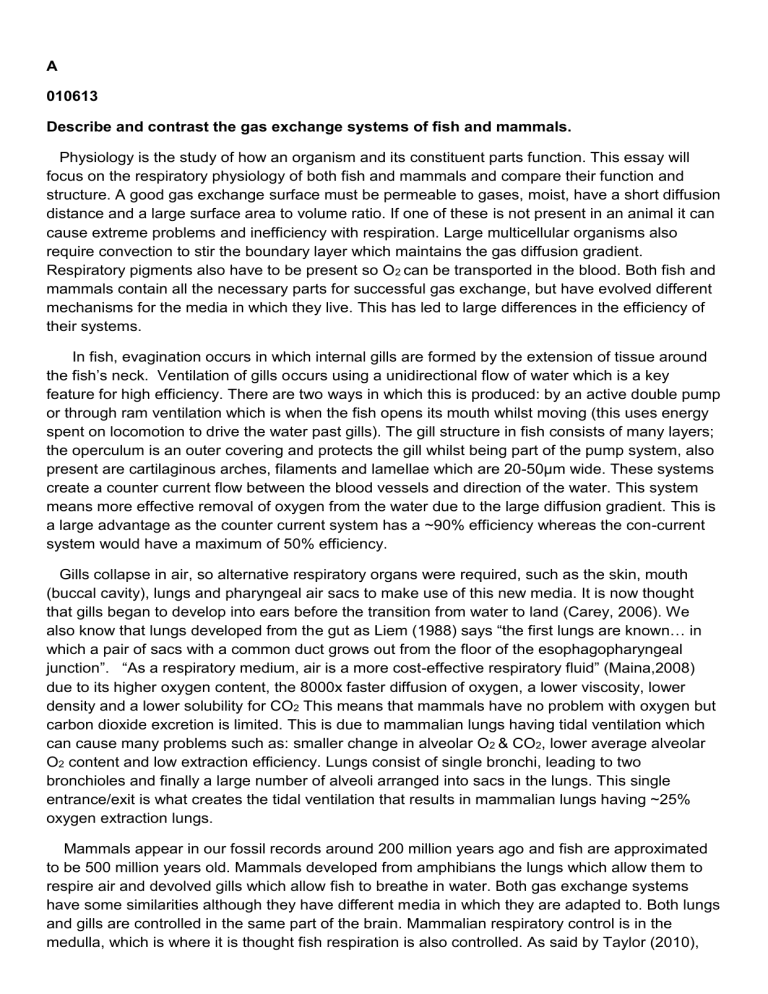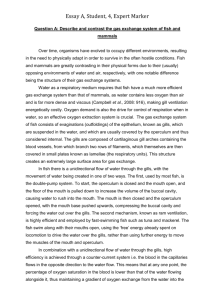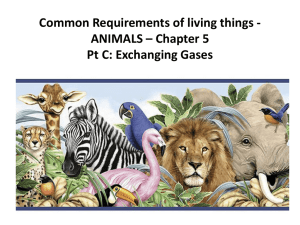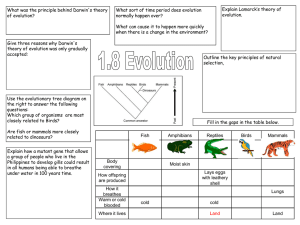oxygen extraction

A
010613
Describe and contrast the gas exchange systems of fish and mammals.
Physiology is the study of how an organism and its constituent parts function. This essay will focus on the respiratory physiology of both fish and mammals and compare their function and structure. A good gas exchange surface must be permeable to gases, moist, have a short diffusion distance and a large surface area to volume ratio. If one of these is not present in an animal it can cause extreme problems and inefficiency with respiration. Large multicellular organisms also require convection to stir the boundary layer which maintains the gas diffusion gradient.
Respiratory pigments also have to be present so O
2 can be transported in the blood. Both fish and mammals contain all the necessary parts for successful gas exchange, but have evolved different mechanisms for the media in which they live. This has led to large differences in the efficiency of their systems.
In fish, evagination occurs in which internal gills are formed by the extension of tissue around the fish’s neck. Ventilation of gills occurs using a unidirectional flow of water which is a key feature for high efficiency. There are two ways in which this is produced: by an active double pump or through ram ventilation which is when the fish opens its mouth whilst moving (this uses energy spent on locomotion to drive the water past gills). The gill structure in fish consists of many layers; the operculum is an outer covering and protects the gill whilst being part of the pump system, also present are cartilaginous arches, filaments and lamellae which are 2050µm wide. These systems create a counter current flow between the blood vessels and direction of the water. This system means more effective removal of oxygen from the water due to the large diffusion gradient. This is a large advantage as the counter current system has a ~90% efficiency whereas the con-current system would have a maximum of 50% efficiency.
Gills collapse in air, so alternative respiratory organs were required, such as the skin, mouth
(buccal cavity), lungs and pharyngeal air sacs to make use of this new media. It is now thought that gills began to develop into ears before the transition from water to land (Carey, 2006). We also know that lungs developed from th e gut as Liem (1988) says “the first lungs are known… in which a pair of sacs with a common duct grows out from the floor of the esophagopharyngeal junction ”. “As a respiratory medium, air is a more cost-effective respiratory fluid” (Maina,2008) due to its higher oxygen content, the 8000x faster diffusion of oxygen, a lower viscosity, lower density and a lower solubility for CO
2
This means that mammals have no problem with oxygen but carbon dioxide excretion is limited. This is due to mammalian lungs having tidal ventilation which can cause many problems such as: smaller change in alveolar O
2
& CO
2
, lower average alveolar
O
2
content and low extraction efficiency. Lungs consist of single bronchi, leading to two bronchioles and finally a large number of alveoli arranged into sacs in the lungs. This single entrance/exit is what creates the tidal ventilation that results in mammalian lungs having ~25% oxygen extraction lungs.
Mammals appear in our fossil records around 200 million years ago and fish are approximated to be 500 million years old. Mammals developed from amphibians the lungs which allow them to respire air and devolved gills which allow fish to breathe in water. Both gas exchange systems have some similarities although they have different media in which they are adapted to. Both lungs and gills are controlled in the same part of the brain. Mammalian respiratory control is in the medulla, which is where it is thought fish respiration is also controlled. As said by Taylor (2010),
“What is not in dispute is the location of the respiratory rhythm generation, which in all vertebrates is concentrated in the brainstem and specifically the medulla oblongata
”. Fish have ram ventilation and although mammals do not, some species have similar mechanisms. For example, kangaroos use energy from locomotion to drive lung ventilation. Similarly, humans synchronise breathing with stride when running. This shows evolutionary mechanisms in action but slightly altered throughout time as the different classes of chordate have evolved.
As previously said air as a respiratory media is a lot better than water, this is due to its high oxygen concentration and diffusion speed. However, fish gills have an oxygen extraction efficiency of ~90% compared to mammalian lungs and their ~25% efficiency. This is due to the manner in which the media enters/exits the respiratory system. In mammals it is the one way system which creates the low efficiency compared to the two way system in fish. Although, mammals need a large surface area for respiration, fish need an even bigger one due to the very low concentrations of oxygen dissolved in the water. This is why the structure consists of many different layers that are all adapted for maximum diffusion compared to lungs having the alveolar sacs only. Lungs contain a surfactant which reduces surface tension in the alveolar fluid layer stopping the collapse of the alveolar layer; gills do not need this as the oxygen is dissolved in water.
Lungs may be less efficient than gills but they do not need to have 90% oxygen extraction efficiency due to the high content in air.
“A litre of air at sea level contains 210 millilitres of oxygen; a litre of seawater at
25 °C contains at most 5ml” (Page, 2009)
. So although at fist gills seem to be the better respiratory mechanism, this extra efficiency is needed to keep the fish alive due to its habitat. Respiration in water also takes a lot more energy, “for every gram of oxygen, air breathers have to move 3.5 grams of air, whereas those relying on gills have to move 100,000g”. This is why creatures such as dolphins and whales have developed blowholes and lungs which suggest that lungs are more advanced and a better respiratory method. Overall, I would claim that lungs are a better gas exchange system as although they are less efficient, they have evolved that way to save energy and allowed animals to respire a new media. Also, lungs are extremely protected by things such as cilia and mucus, as they are the only internal organ that is exposed to the external environment, which shows huge defensive mechanisms against air and the infections it carries.
Bibliography
1. E.W.Taylor, C.A.C.Leite, D.J.Mckenzie, T.W.Wang, (2010), Control of respiration in fish, amphibians and reptiles, Brazilian Journal of Medical and Biological Research , Volume
43: 409-424.
2. J.N.Maina, (2002), Structure, Function & Evolution of the gas exchanges: comparative perspectives, Journal of Anatomy, Volume 201(4) : 281-304
3. B.Carey, (2006), Human Ear evolved from Ancient Fish Gills, Live Science, http://www.livescience.com/558-human-ears-evolved-ancient-fish-gills.html, 24/11/2013
4. K.F.Liem, (1988), Form and Function of Lungs: The Evolution of Air Breathing Mechanisms,
Interactive and Comparative Biology, Volume 28(2) : 739-759
5.
M.L.Page, (2009), Why whales don’t have gills, New Scientist, http://www.newscientist.com/blogs/shortsharpscience/2009/08/why-whales-dont-havegills.html, 23/11/2013










